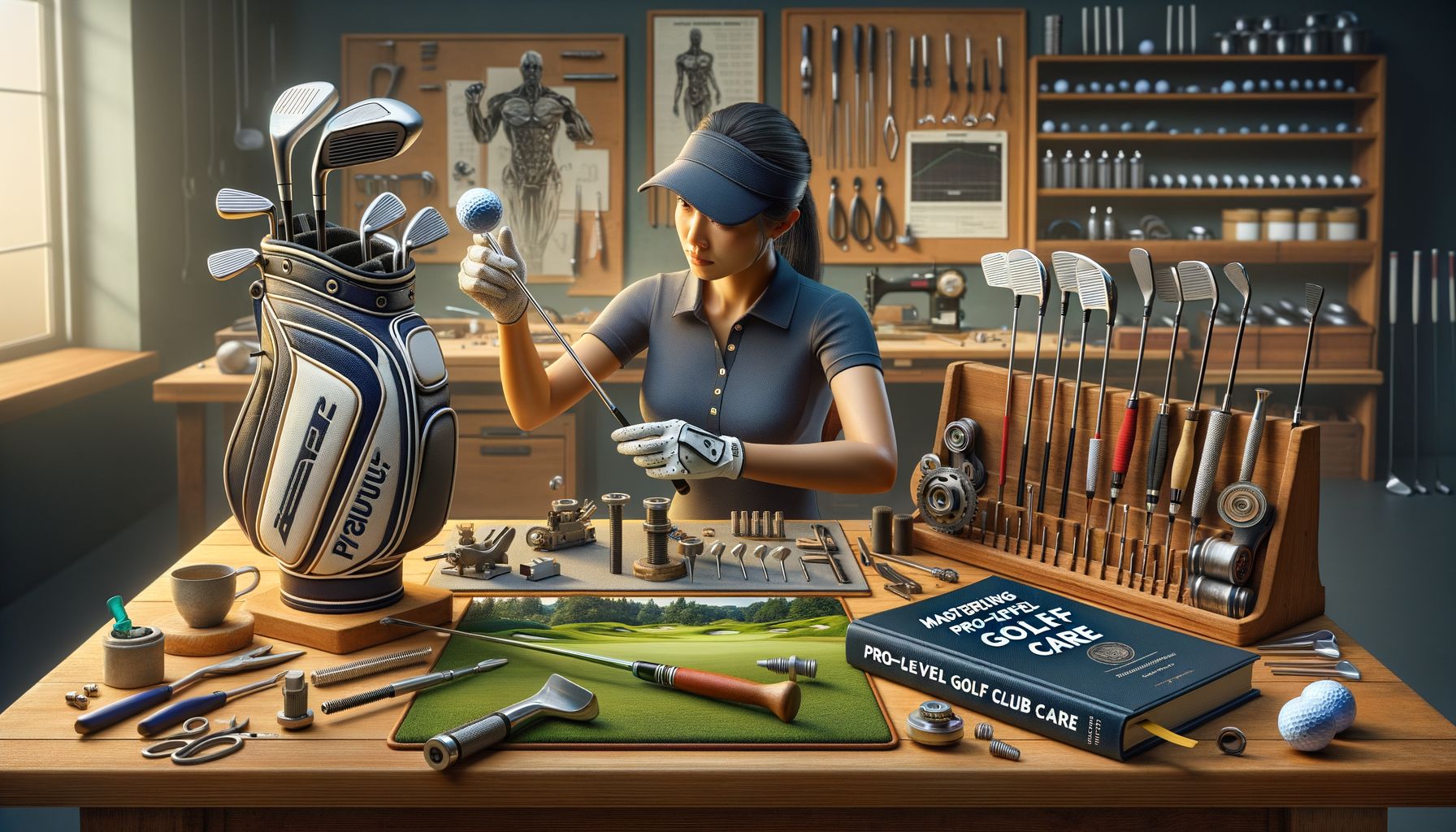
Mastering Pro-Level Golf Club Care: The Ultimate Guide from Tour Pro Golf Clubs
Golf is a game of precision, and every detail counts—especially when it comes to your equipment.
Whether you’re an aspiring tour pro or a dedicated weekend warrior, maintaining your golf clubs at a
professional standard is crucial for peak performance and longevity. At Tour Pro Golf
Clubs, we bring you closer to the secrets of the world’s top golfers, including how
they care for their most trusted tools. In this comprehensive guide, you’ll discover the best
cleaning techniques, storage solutions, inspection protocols, and more—ensuring your clubs always
play (and look) like those on the PGA Tour.
Cleaning Techniques for Pro-Level Golf Clubs
Keeping your clubs spotless isn’t just about aesthetics—it’s about maximizing performance. Dirt and
debris can alter ball flight, spin rates, and even distance. The world’s best players trust
meticulous cleaning routines to keep their equipment tournament-ready.
Start by preparing a bucket of warm water with a mild dish soap. Dip a soft-bristled brush (an old
toothbrush works well) into the solution and gently scrub the clubface, paying close attention to
the grooves where dirt can accumulate. For irons and wedges, ensure each groove is clear; use a
specialized groove cleaner for stubborn debris. After scrubbing, rinse each clubhead with clean
water and dry thoroughly with a microfiber towel.
Woods and putters require extra care—avoid soaking them entirely to protect delicate finishes and
adhesives. Instead, wipe these clubs with a damp cloth and dry immediately. For grips, use warm
soapy water to remove oils and sweat buildup, which can cause slippage during play.
Pro Tip: After every round or practice session, do a quick wipe-down to prevent dirt
from hardening. This daily habit keeps your clubs looking new and performing at their best.
Proper Storage Solutions for Longevity
Even the finest clubs lose their edge if stored improperly. Tour pros invest in optimal storage
solutions to preserve their equipment between rounds and seasons.
Always store your clubs in a cool, dry environment—avoid garages or car trunks where temperature
fluctuations can damage shafts and grips. Humidity accelerates rust on steel shafts and clubheads;
consider using silica gel packs in your golf bag or storage locker to absorb excess moisture.
For home storage, invest in a dedicated golf bag stand or wall-mounted rack that keeps clubs upright
and separated. This prevents warping of shafts and unnecessary pressure on clubheads or grips. If
you have custom-fitted clubs from brands like Titleist or TaylorMade, follow manufacturer guidelines
for long-term storage.
Investing in proper storage not only extends the life of your equipment but also protects your
investment—pro-level golf clubs can cost upwards of $2,500 per set.
Regular Inspection and Wear Assessment
Tour professionals regularly inspect their gear for signs of wear—a habit that prevents costly
surprises during competition. You should adopt this practice as part of your maintenance
routine.
Begin by examining clubfaces for dings, scratches, or worn grooves that could affect spin control.
Inspect ferrules (the small collars where shaft meets head) for cracks or separation—a sign that
re-shafting may be necessary soon.
Check shafts (steel or graphite) for dents, rust spots, or splintering; even minor imperfections can
impact swing consistency or cause sudden breakage under load. For adjustable drivers like those from
Callaway’s Epic series or TaylorMade’s SIM line, ensure all screws are tight but not
over-torqued.
Grips deserve special attention: look for smooth spots (a sign of wear), cracking rubber, or
slickness caused by accumulated oils. Replace grips at least once per season—or more often if you
play frequently.
Inspection Checklist:
- Examine clubfaces/grooves after every round
- Check ferrules monthly
- Inspect shafts quarterly
- Assess grip condition monthly
- Tighten adjustable hosels as needed
Routine inspections help catch problems early—saving money on repairs and avoiding unexpected issues
on the course.
Shaft and Grip Maintenance Essentials
The shaft is the engine of every golf club—its integrity determines feel and performance. Likewise,
grips are your only point of contact with each swing; both require focused maintenance to deliver
pro-level results.
Shaft Care:
Steel shafts should be wiped down after every round to prevent rust—especially if you’ve played in
wet conditions. Use a lightly oiled cloth periodically to provide extra protection against
corrosion. For graphite shafts (popular in drivers like Ping G430 Max), avoid abrasive cleaners;
instead use damp microfiber towels only.
Avoid leaning on your clubs during play or transport—this can cause subtle bends that alter launch
characteristics over time. If you notice persistent vibration or strange ball flights after impact
(despite solid swings), have your shafts checked by a certified club technician.
Grip Care:
Clean grips regularly using warm soapy water and a soft brush; this removes sweat salts that degrade
rubber compounds over time. Dry thoroughly before storing to prevent mildew growth—a common issue in
humid climates like Florida or Georgia.
When replacing grips (a service offered by retailers such as Golf Galaxy), choose models that match
your hand size and preferred texture—for example, Golf Pride MCC Plus4 for added traction in wet
conditions or Lamkin Crossline for classic feel.
Neglecting shaft or grip care can lead to erratic shots—even with tour-quality heads—so make these
steps part of your routine maintenance calendar.
Protecting Clubfaces and Grooves
Clubface integrity is essential for generating optimal spin rates—a critical factor in pro-level
shotmaking. Even minor scratches can affect trajectory control on approach shots or around the
greens.
Always use headcovers on woods and putters when not in play; modern covers from brands like Scotty
Cameron offer plush interiors that shield against nicks during transport. For irons and wedges
(where most wear occurs), consider neoprene slip-on covers if you travel frequently or store
multiple sets together.
After each shot from sand bunkers or rough terrain, check grooves for embedded grit—a quick brush
with a groove tool restores sharpness instantly. Periodically deep-clean grooves using specialized
groove sharpeners (such as those from GrooveMaster); however, avoid excessive sharpening which could
render clubs non-conforming under USGA rules.
Never hit range balls with visible cuts or cracks—they can damage premium forged faces found on
high-end models like Mizuno MP-20s or Titleist Vokey SM9 wedges.
Top Ways Pros Protect Their Clubfaces:
- Always use headcovers off-course
- Wipe down after each shot
- Avoid hitting off hard surfaces (e.g., cart paths)
- Deep-clean grooves monthly
- Store irons separately when traveling
These habits ensure consistent ball-striking—and preserve resale value should you upgrade later
through Tour Pro Golf Clubs’ trade-in programs.
Travel Tips for Safeguarding Equipment

Professional golfers travel thousands of miles each season—with their clubs as prized cargo.
Protecting them en route is vital whether heading to Augusta National or your local tournament
circuit.
Invest in a high-quality travel case—hard-shell models like Club Glove Last Bag Large Pro ($399)
offer robust protection against airline mishandling while fitting oversized tour bags comfortably
inside. For extra security during air travel:
- Remove clubheads from adjustable drivers/fairways when possible
- Wrap clubheads in bubble wrap before placing them inside headcovers
- Use towels between irons/wedges to prevent clanking
- Fill empty space inside travel bag with clothing/shoes for shock absorption
- Always label bags clearly with contact information
Upon arrival at your destination hotel or course:
- Unpack clubs immediately
- Inspect all components for transit damage
- Allow grips/shafts to acclimate before first round
Frequent travelers may also benefit from annual insurance policies covering loss/damage—providers
such as American Golf Travel Insurance offer plans starting at $120/year with coverage up to $5,000
per set.
Adopting these precautions ensures peace of mind—and keeps pro-level gear ready no matter where golf
takes you next.
Seasonal Maintenance Routines
Changing seasons bring unique challenges—and opportunities—for comprehensive golf club care. Just as
tour pros adjust routines based on climate shifts across the PGA schedule, amateurs should tailor
maintenance throughout the year.
Spring:
Start with deep cleaning after winter storage; check all moving parts (hosels/adjustable weights)
for corrosion due to inactivity. Re-grip if rubber feels stiff from cold weather exposure; test
loft/lie angles using digital tools available at major retailers like Dick’s Sporting Goods ($40–$60
per fitting).
Summer:
Focus on moisture management: wipe down shafts/grips after humid rounds; store equipment indoors
overnight rather than hot car trunks where temperatures may exceed 120°F—potentially weakening epoxy
bonds holding heads/shafts together.
Fall:
Inspect grooves closely after heavy summer play; sharpen edges carefully if needed while staying
within USGA conformity limits (see manufacturer specs). Replace worn-out headcovers before storing
gear ahead of winter months—protection against dust/mildew is key during extended downtime.
Winter:
If not playing regularly due to snow/frost: clean all components thoroughly before storing indoors;
loosen adjustable hosel screws slightly so materials aren’t under tension all season long; place
silica gel packs inside bags/cases as added moisture defense until spring returns.
A disciplined seasonal approach maximizes both performance consistency—and overall lifespan—for any
set purchased through Tour Pro Golf Clubs’ exclusive inventory lines featuring brands like Srixon
ZX7s or Cobra King Forged Tec Irons.
Professional Servicing and Custom Fitting

While DIY maintenance covers most needs, periodic professional servicing ensures peak performance—the
same principle guiding every tour player’s support team behind the scenes at major championships
worldwide.
Schedule annual “tune-ups” at certified fitting centers such as True Spec Golf ($125–$350 per
session). Services typically include:
- Loft/lie angle adjustments via digital bending machines
- Shaft frequency analysis ensuring matched flex profiles across full set
- Swing weight balancing tailored precisely to individual tempo preferences
- Grip replacement/installations based on latest hand measurement data
- Launch monitor diagnostics providing real-time feedback on spin/launch numbers
Many top retailers—including PGA TOUR Superstore—offer free basic fittings with purchase of new sets
valued over $1,000+. Advanced customizations may involve hot-melting driver heads (for enhanced
sound/feel), tip-trimming graphite shafts for lower launch/spin profiles favored by elite
ball-strikers like Rory McIlroy or Scottie Scheffler in 2024 events.
Don’t overlook periodic re-checks: as swing mechanics evolve through lessons/practice changes—or
physical factors such as strength/flexibility shift over time—fine-tuning specs keeps gear aligned
perfectly with current game needs rather than outdated baselines from years past.
By adopting these pro-level care strategies—from cleaning routines through expert servicing—you’ll
enjoy consistently superior performance from every club in your bag while protecting one of golf’s
most important investments. At Tour Pro Golf Clubs, we’re committed to helping
golfers everywhere achieve their best through knowledge drawn directly from inside the ropes.